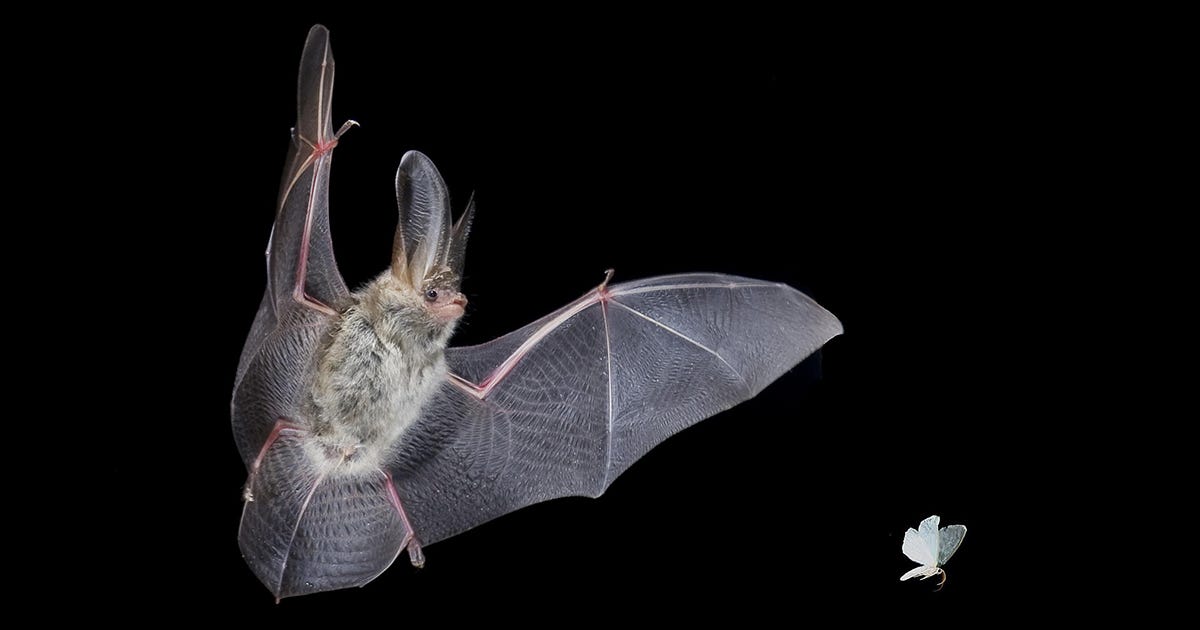Imagine the intellectual challenges of living life as a bat. You wake up in pitch darkness, in a colony of up to 20 million of your fellow bats1. You and your fellow 20 million bats have to navigate in the dark out of the cave into the open air without colliding into each other or the cave walls.
Once you’re in the open air, you have to go out in search of flying insects to eat. This is, again, in darkness, and these insects are likely to be performing acrobatic turns to avoid you in mazes of tree branches. Your flying skills are what will allow you to catch these insects, but, of course, your echolocation is what’s going to allow you to sense and target these insects. It’s far too dark to target them by sight.

But relying on echolocation is another immense intellectual challenge. Think about how echolocation works. You, as a bat, will emit sounds into the world. These sounds bounce off of objects and return to your ears. If you want to use this echo to successfully eat a moth and not hit a tree branch while doing loop-de-loops at top speeds, you will have to be able to use the echo to figure out
a) how far objects are away from each other
b) the size and shapes of objects, even if they are on top of one another (e.g. a moth on a leaf)
c) the relative position of the object compared to you on the x, y, and z axis
d) if and where the object is moving
This is really difficult! What this looks like in practice is that bats are continually emitting incredibly loud pulses of ultrasonic sound in cones in front of them2. Every time they emit sound they have to quickly close their ears to avoid deafening themselves, then they quickly open their ears again to hear the echo.
These pulses get more rapid as they zero in on a target. But, flying towards the target presents additional challenges. First, they need to still match up the echo with the original call even when they move closer to the target, which they do by adjusting the sensitivity of their ears. Second of all, if you’re a “constant frequency” bat, your ears are specialized to only hear certain frequencies3. The doppler effect means that your echoes will be shifted to a higher frequency as you get closer to the target. So, you also need to downshift your calls to make sure the echoes stay within your ears’ hearing range.
Bats are doing all of this in a noisy, complex environment. Not only is it filled with branches and buildings, but it’s also filled with a bunch of other bats screaming incredibly loudly. And bats have to do this continually, eating dozens of insects a night. These insects are also flying around trying to avoid these bats, even camouflaging themselves from the bats’ echolocation4.
And, again, the fundamental way that they’re doing all of this is just by emitting sounds, listening for the echo, and then interpreting. Because of this, huge parts of bats’ brains are dedicated to the task of interpreting these echoes. In fact, there are specific neurons in bats’ brains that only respond to certain combinations of sound frequency and timing.
And this is why I want to frame this specifically as an intellectual challenge, rather than just a physical ability. Yes, bats have physical abilities with regards to echolocation that we, as humans, do not have. They have incredible control over their voice and their ears. In fact, their vocal muscles contract at up to 200 times per second, which is the highest contraction rate of any muscle in the animal kingdom.
But, they also have intellectual abilities that we do not have. If you were given the voice and ears of a bat, you still would not be able to navigate through a forest in the dark. You certainly would not be able to catch a moth on the wing. You’d probably wouldn’t make it out of the cave.
Humans value the sort of intelligence that we have used to become the dominant species on planet Earth. But that’s not the only form of intelligence. Intelligence is, broadly speaking, the ability to receive, interpret, and act on data from the outside. There are entire categories of data that we, and even our machines, cannot really interpret or act on.
So, never mind if our AIs will ever surpass us in intelligence. The real question is: will they ever surpass bats?
This blog post owes a lot to Ed Yong’s excellent book on animal senses, An Immense World. Also, shout out to Thomas Nagel’s What Is It Like to Be A Bat?, the title and content of which is haunting me as I write a blog post about what it’s like to be a bat.
Big brown bats also emit a cone beneath them, probably to measure their own altitude.
The advantage to keeping call frequency constant is that it allows bats to easily detect when frequency of the echo is shifted because of something their prey did, like fly away or flap their wings. The disadvantage to keeping call frequency constant is that bats can no longer use long wavelength (low frequency) and short wavelength (high frequency) calls to determine coarse and fine grained features of whatever object they’re examining.
Like by having big tails that make it difficult for the bats’ echolocation to tell where the moth ends and the tail begins.
My guess would be that bats whose prey is more acrobatic would have constant frequency calls, and more stationary would have frequency modulated, but I haven’t looked into it.